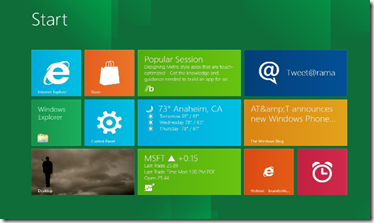
Just a placeholder, a forecast, a prediction, a hope. Windows 8 is coming. Most people have heard that in one way or another or seen a picture, or something.
Windows 8, if done correctly, can change everything. We’ve worked with clients to give them access to much of their Windows “stuff” on smartphones and tablets in some way shape or form. It’s not straightforward, no matter what Microsoft, Apple, Egnyte, or anyone else says. Imagine if your smartphone or tablet actually ran Windows, and ran it well - if your stuff were just there, in largely the same way in largely the same place across your phone, tablet, laptop and desktop.
That would really be something. And Windows is really the only platform that could do it, given current market share numbers.
But we’re not talking about Windows as we all know it. We’re talking about the same Windows files and data and applications, but running in an entirely different way, on an entirely different OS.
We’ve been looking at Windows 8’s beta release for a couple of months and like all betas it’s not finished yet, but if Microsoft can pull this off, it has the potential to make using a phone, tablet, laptop and desktop a much more seamless experience than has been possible, or could be possible, with any other platform, ever. With the futures of Microsoft, Intel, AMD, Dell, Lenovo, HP, Nokia, the cellular carriers, and a thousand other companies that nobody’s ever heard of all tied up together in this, there certainly is potential for a circular firing squad. If, however, they can focus and really bring this off, it’ll be the most significant platform upgrade since Windows itself. And yes, I do know about MacOS. And yes, I’m guessing Apple has a few tricks up its sleeve too – MacOS 11 anyone? iOS 6? Maybe some convergence? A unified MacOS and iOS would be significant, since Apple still has a majority share of the tablet market, and a significant share of the smartphone market. But this would pale in comparison to what Windows 8 and Windows Phone 8 have the potential to do, if done correctly.
The convergence of phone, tablet, laptop and desktop. Not to mention radio, television, and movies, is happening. Microsoft and Apple still control the computer market with 92% and 4% respectively (that’s 96% total; the rest is Linux and “other”), and while Android tops the smartphone market, and will probably continue to do so, Gartner and IDC have predicted that Windows Phone will be #2 within 3 years. And Windows 8 comes out this year, maybe along with Windows Phone 8, which will in some large part be based on Windows 8.
This all started just a couple of years ago, remember, and 2012 may not be the year that the earth changes rotation and we all go flying off into space, but Windows 8, Windows Phone 8 and maybe MacOS 11 and some sort of MacOS/iOS convergence, could be the earth-shattering occurrences the Mayans predicted!
This should be fun.
Just in time for Christmas!
 Saturday, July 14, 2012 at 8:45AM
Saturday, July 14, 2012 at 8:45AM  Clients,
Clients,  Cloud computing,
Cloud computing,  Email,
Email,  Tools
Tools 
